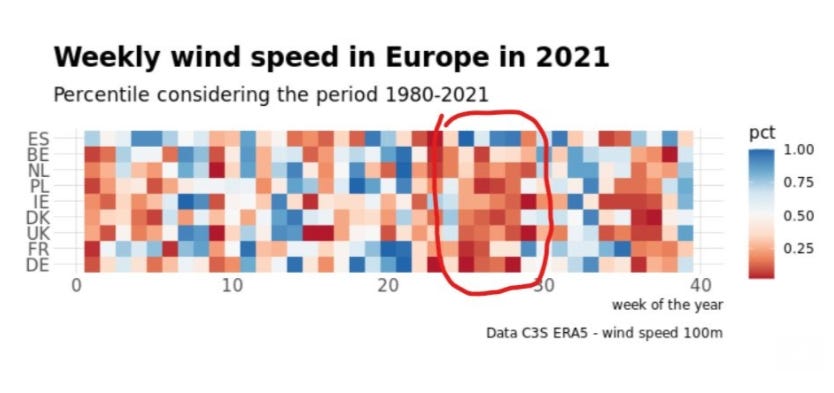Weekly Roundup #7
On #Hydrogen #energy markets #global trade #IEA #WEO-2021 #wind #flooding #sea level rise
Bonjour everyone,
Is climate change affecting the average wind speeds in Northern Europe? How will sea level rise affect your city? New report published by IEA shows optimistic grow in clean energy technologies, however, this progess is far too slow to avoid warming. The economy and players of the future hydrogen market in a map
CHART OF THE WEEK - Gone with the wind:
Via Exponential View and Matteo de F:
One challenge with many renewables is that they are intermittent. Until large-scale energy storage comes on stream (see COTW#46), we build more resilient networks for electricity import/export or we commission more nuclear reactors (thank you, France!), renewables may be fragile. Consider wind: Compared to 1980-2021, the breezes across much of northern Europe (which has a lot of wind generating capacity) were substantially calmer, indeed mainly in the lowest quartile compared to the historical average. This has already impacted generating capacity and the share price of wind energy providers such as Orsted.
A look on how climate change could drown landmarks around the world
Just 3 degrees Celsius (5.4 degrees Fahrenheit) of global warming stands between Cuba’s Plaza de La Catedral looking typically dry or looking like something straight out of the myth of Atlantis. The iconic plaza in Old Havana is just one of many landmarks that could face a watery grave in the future if greenhouse gas emissions from burning fossil fuels continue unabated.
The International Energy Agency (IEA) has published the World Energy Outlook for 2021 (WEO-2021). It shows that a new energy economy is emerging around the world as solar, wind, electric vehicles and other low-carbon technologies flourish. But as the pivotal moment of the COP26 Climate Change Conference approaches, the WEO-2021 makes it clear that this clean energy progress is still far too slow to put global emissions into sustained decline towards net zero, highlighting the need for an unmistakable signal of ambition and action from government leaders at COP26.
MAP OF THE WEEK - A deep dive into the future of the hydrogen economy and its applications
As a result of these forces, the price of hydrogen made from renewable sources is plunging, and seems likely to keep doing so. Bloombergnef predicts the price of green hydrogen using pem electrolysis could fall to just $2 per kg by 2030, making it competitive with blue hydrogen (see chart 2). Morgan Stanley goes significantly further, arguing that at the very best locations for renewables in America, green hydrogen will be able to match grey hydrogen’s $1/kg “in 2-3 years”.
If you want to send us an idea or a tip, a #ClimateTech company that we should have a look at, or if you have any questions, please reach us at: davidcongeof@gmail.com or arraiz.p.daniel@gmail.com.
Thank you for supporting Explorationists and ClimateTech Talks






